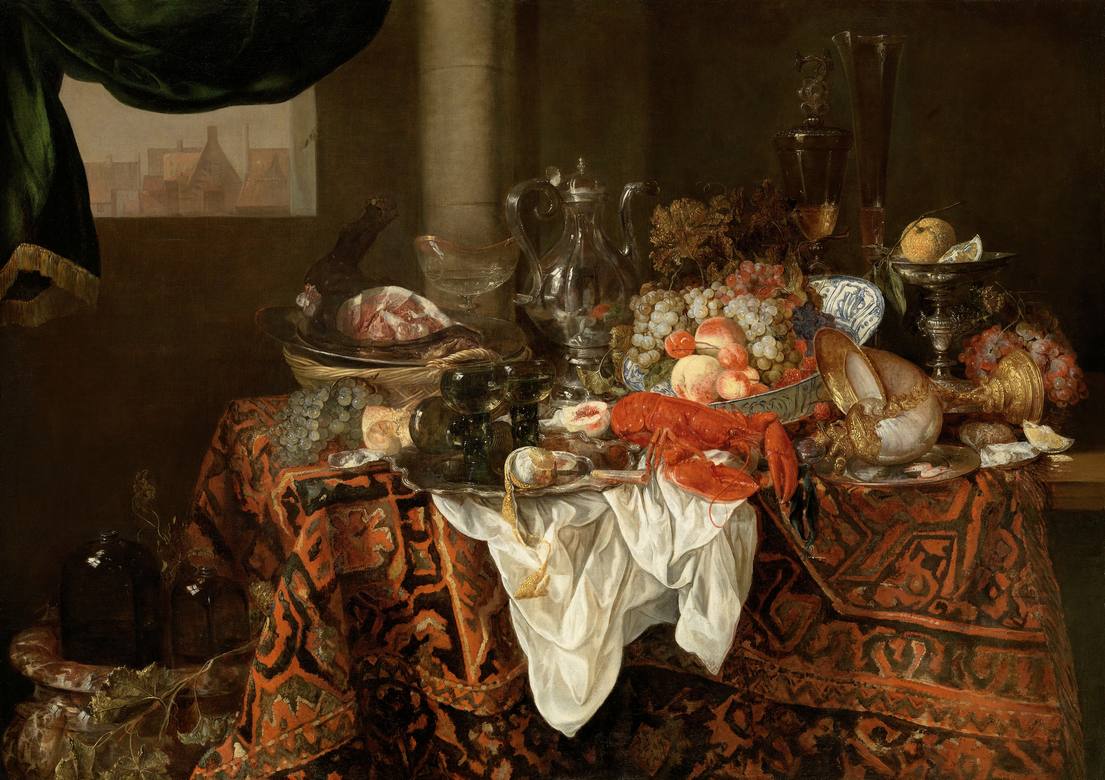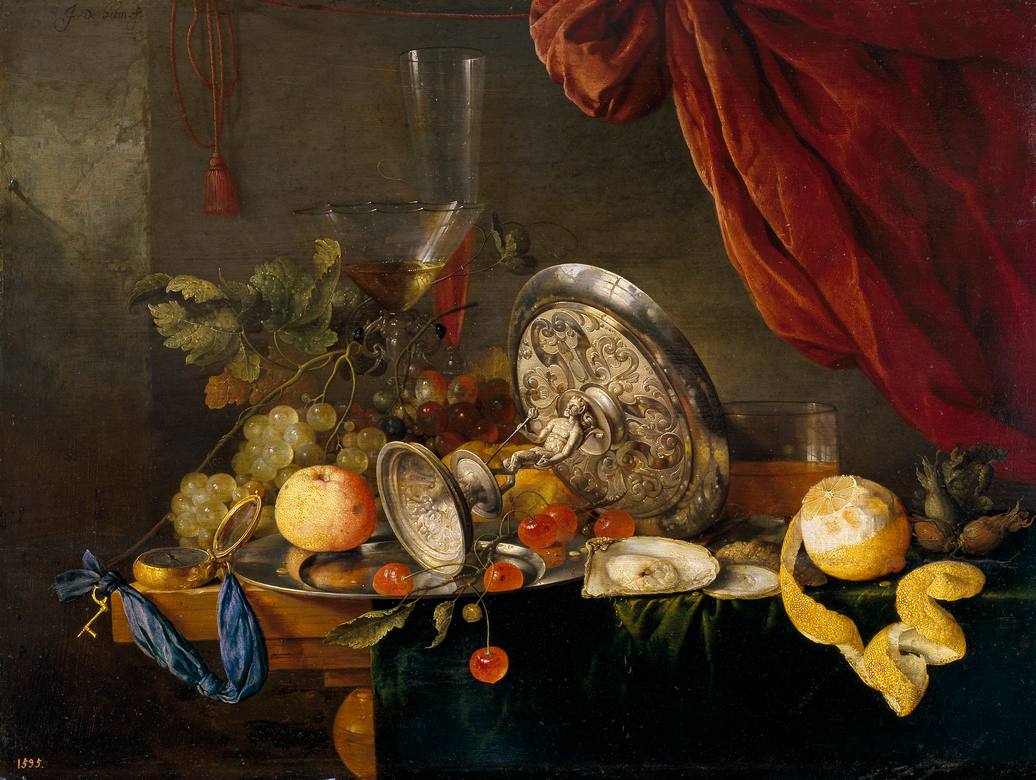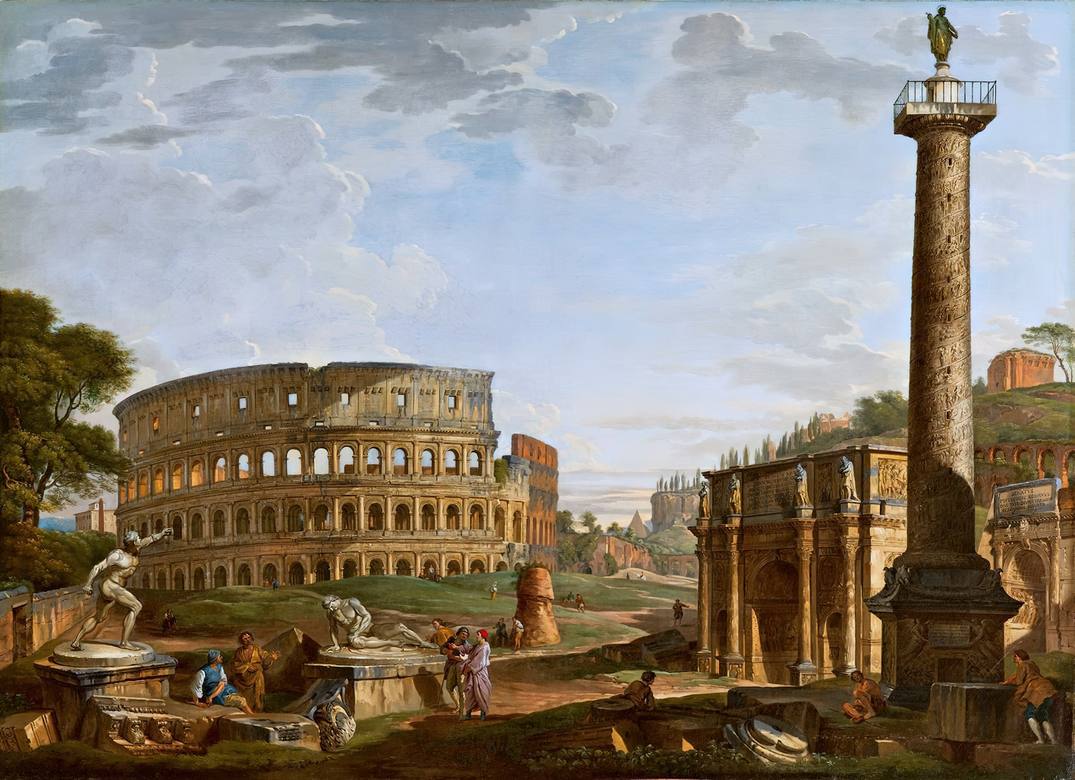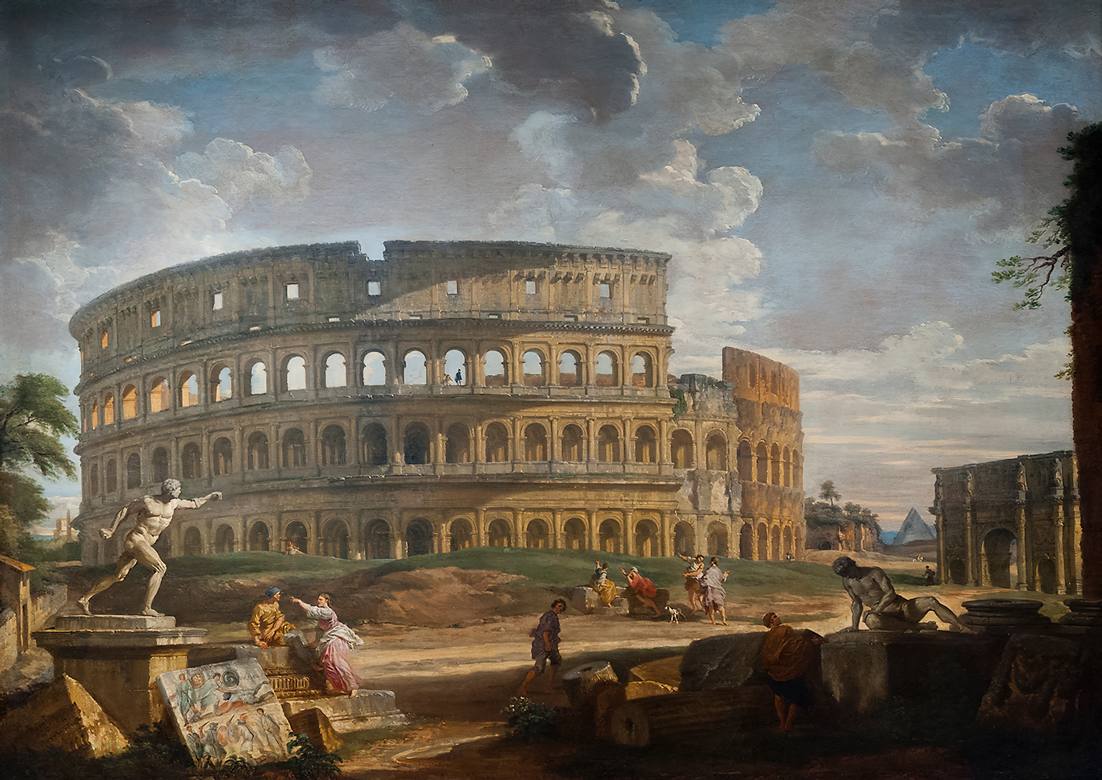
Giovanni Paolo Panini
the Serial Painter
Was he an inspiration for Canaletto's working methodology?
Since painting was considered a job, Giovanni Paolo Panini had his "factory" set to produce as many paintings as would be requested, a full production chain, and a few image types no doubt were more successful.
Panini and his studio were tendentially working on big paintings, 2x2 meters of size, which would fill up a wall in Castles and rich houses.
On the other hand, Canaletto was requested to work on smaller formats by his Patrons: Owen Swiny or Joseph Smith would usually limit his size choices in no more than 1x2 meters and even less, 70x100 cm sometimes, as they were easier to transport from Venice (my assumption) and maybe they were less expensive? or faster to make? (detailism in Canaletto's works is quite impressive). A big postcard, anyway.
Very often Panini's serial paintings are so alike one from the other, that hard work is required to find the differences from one painting to the other, as we can see in these examples here:
We can say that mass production of paintings was going on in Panini's studio, starting from around 1730.
Nothing strange, but simply a trend which could have been determined by the factor of Rome being such an important (and required) tourist destination, and the desire of these rich tourists to "take home a souvenir" to share memories and sensations with family and friends.
And a 4 square meter of beautiful painting, sure did the work.
And tastes in acquiring Art were changing in those times.
Holland was in the process of moving out from Catholicism to enter the Protestant Religion, and the artistic tendency had changed already because of a change in "trends" or "tastes" of who could afford to buy paintings to decorate their homes.
Food Art and Genre Painting had already been trendy for a while (end of XVI - mid XVII century):
Also Johannes Vermeer, in mid XVII century, who had started his career as a professional painter with Religion inspired paintings:
... had moved to "Genre Painting" in his quest for recognition & success ...
Interior of St. Peter's Basilica
![Giovanni Paolo Panini: [1735] - Interior of St. Peter's, Rome - Oil on canvas - Norton Simon Museum, Pasadena, CA](../images_db/Giovanni-Paolo-Panini-1735--gpp077-Rome-St-Peters--Norton-Simon-Museum-gp1.jpg)

Giovanni Paolo Panini: [1735] - Interior of St. Peter's, Rome
Oil on canvas - Norton Simon Museum, Pasadena, CA - size (HxW): 153x219.7 cm
Ancient and Modern Rome Galleries of Paintings
![Giovanni Paolo Panini: [1758] - Gallery of views of ancient Rome - Oil on canvas - Musée du Louvre, Paris](../images_db/Giovanni-Paolo-Panini-1758--gpp002-Gallery_of_views_of_ancient_Rome__Louvre_0000144094_OG-gp1-dlp1.jpg)

Giovanni Paolo Panini: [1758] - Gallery of views of ancient Rome
Oil on canvas - Musée du Louvre, Paris - size (HxW): 230x300 cm
The Colosseum
![Giovanni Paolo Panini: [1747] - View of the Colosseum - Oil on canvas - The Walters Art Museum, Baltimore, MD](../images_db/Giovanni-Paolo-Panini-1747--gpp027-View-of-the-Colosseum--The-Walters-Art-Museum-c81i-gp1.jpg)

Giovanni Paolo Panini: [1747] - View of the Colosseum
Oil on canvas - The Walters Art Museum, Baltimore, MD - size (HxW): 82x133.2 cm
The Forum


![Giovanni Paolo Panini: [1736] - A Capriccio View of Rome with Ancient Ruins and the Flaminian Obelisk - Oil on canvas](../images_db/Giovanni-Paolo-Panini-1736--gpp052-A-Capriccio-View-of-Rome-with-Ancient-Ruins-and-the-Flaminian-Obelisk-510800ld.jpg)
![Giovanni Paolo Panini: [1740] - Imaginary Landscape with Roman Ruins - Oil on canvas - Columbia Museum of Art, Columbia, SC](../images_db/Giovanni-Paolo-Panini-1740--gpp051-Imaginary-Landscape-with-Roman-Ruins--Columbia-Museum-of-Art-gp.jpg)
![Giovanni Paolo Panini: [1731] - Preparations to Celebrate the Birth of the Dauphin of France in the Piazza Navona - Oil on canvas - National Gallery of Ireland](../images_db/Giovanni-Paolo-Panini-1731--gpp098-Preparations-to-Celebrate-the-Birth-of-the-Dauphin-of-France-in-the-Piazza-Navona-119317930_o-gp.jpg)
![Giovanni Paolo Panini: [1729] - Preparazione per i fuochi d artificio Tenutasi a Piazza Navona, a Roma, per celebrare la nascita del Delfino (Preparation For the Firework Display Held at Piazza Navona, Rome, to Celebrate the Birth of the Dauphin) - Oil on canvas - Musée du Louvre, Paris](../images_db/Giovanni-Paolo-Panini-1729--gpp031-The-Piazza-Navona-in-Rome--Louvre-0000340740_OG-gp1_dlp3.jpg)

![Willem Claesz. Heda: [1637] - Martwa natura - Oil on canvas - Wawel Castle](../images_db/Willem_Claesz._Heda_1637__x165_Martwa_natura-gp.jpg)
![Pieter Claesz: [1635-39] - Ontbijt of silver and glassware on a draped table - Oil on canvas - Private Collection](../images_db/Pieter_Claesz_1635-39__x160_Ontbijt_of_silver_and_glassware_on_a_draped_table_with_v104729_1.jpg)

![Gabriel Metsu: [ca. 1665] - A man and a woman beside a virginal - Oil on canvas - National Gallery, London](../images_db/Gabriel_Metsu_1665ca__x151_A-man-and-a-woman-beside-a-virginal__National-gallery-london-gp.jpg)
![Pieter de Hooch: [1658] - The Courtyard of a House in Delft - Oil on canvas - National Gallery](../images_db/Pieter_de_Hooch_1658__x155_The_Courtyard_of_a_House_in_Delft_dlp1.jpg)
![Johannes Vermeer: [ca. 1653-56] - Diana and her Companions - Oil on canvas - Mauritshuis, The Hague](../images_db/Johannes-Vermeer--1653-56ca--x168-01__Diana-and-her-Companions.jpg)
![Johannes Vermeer: [ca. 1654-56] - Christ in the House of Martha and Mary - Oil on canvas - National Gallery of Scotland, Edinburgh](../images_db/Johannes-Vermeer--1654-56ca--x169-02__Christ-in-the-House-of-Martha-and-Mary.jpg)
![Johannes Vermeer: [ca. 1657-61] - The Milkmaid - Oil on canvas - Rijksmuseum, Amsterdam](../images_db/Johannes-Vermeer--1657-61ca--x170-07__The-Milkmaid.jpg)
![Johannes Vermeer: [ca. 1662-65] - The Music Lesson - Oil on canvas - The Royal Collection, The Windsor Castle](../images_db/Johannes-Vermeer--1662-65ca--x172-13__The-Music-Lesson.jpg)
![Giovanni Paolo Panini: [1756-57] - The Interior of Saint Peter’s with the Visit of the Duc de Choiseul - Oil on canvas - The Boston Athenaeum](../images_db/Giovanni-Paolo-Panini-1756-57--gpp008-The-Interior-of-Saint-Peter-s-with-the-Visit-of-the-Duc-de-Choiseul-b40eb-gp.jpg)
![Giovanni Paolo Panini: [1730] - Visit of Cardinal Melchior de Polignac to St. Peter's Basilica - Oil on canvas - Musée du Louvre, Paris](../images_db/Giovanni-Paolo-Panini-1730--gpp071-Le_cardinal_Melchior_de_Polignac_visitant_Saint-Pierre_de_Rome_Louvre-0000399866_OG-gp1-dlp1.jpg)
![Giovanni Paolo Panini: [before 1742] - Rome - The Interior of St. Peter's - Oil on canvas - The National Gallery, London](../images_db/Giovanni-Paolo-Panini-1742before--gpp013-Rome--The-Interior-of-St.Peter-s.jpg)
![Giovanni Paolo Panini: [1754] - Interno della basilica di San Pietro a Roma (Interior of St. Peter's Basilica in Rome) - Oil on canvas - Ca' Rezzonico, Venezia](../images_db/Giovanni-Paolo-Panini--gpp012-Interno_della_basilica_di_San_Pietro_a_Roma_01_Ca-_Rezzonico.jpg)
![Giovanni Paolo Panini: [1734] - Interior view of St. Peter's Church in Rome - Oil on canvas - Kunsthaus, Zürich](../images_db/Giovanni-Paolo-Panini-1734--gpp016-interior-of-st-peters-in-rome-426dfb_b-gp2.jpg)
![Giovanni Paolo Panini: [1754] - Interior of St. Peter's, Rome - Oil on canvas - Metropolitan Museum of Art, New York, NY](../images_db/Giovanni-Paolo-Panini-1754--gpp010-Interior-of-St.-Peter-s--Rome-MET-516038ld.jpg)
![Giovanni Paolo Panini: [1731] - Interior of St. Peter's, Rome - Oil on canvas - Landesmuseum, Hannover](../images_db/Giovanni-Paolo-Panini-1731--gpp011-Interior-of-St.-Peter-s--Rome--Landesmuseum-Hannover_2a.jpg)
![Giovanni Paolo Panini: [1731] - Interior of St. Peter's Basilica in Rome - Oil on canvas - Saint Louis Museum of Art](../images_db/Giovanni-Paolo-Panini-1731--gpp009-Interior-of-St.Peter-s-Basilica-in-Rome.jpg)
![Giovanni Paolo Panini: [1754-55] - Interior of St Peter's Cathedral in Rome - Oil on canvas - Hermitage Museum, St Petersburg](../images_db/Giovanni-Paolo-Panini-1754-55--gpp015-Interior-of-St-Peter-s-Cathedral-in-Rome--Hermitage-Museum-WOA_IMAGE_1.jpg)
![Giovanni Paolo Panini: [1749] - Interior of a Picture Gallery with the Collection of Cardinal Silvio Valenti Gonzaga - Oil on canvas - Wadsworth Atheneum Museum of Art, Hartford, CT](../images_db/Giovanni-Paolo-Panini-1749--gpp001--Interior-of-a-Picture-Gallery-with-the-Collection-of-Cardinal-Silvio-Valenti-Gonzaga--Wadsworth-Atheneum-gp.jpg)
![Giovanni Paolo Panini: [1754-57] - Gallery of views of ancient Rome - Oil on canvas - Staatsgalerie Stuttgard](../images_db/Giovanni-Paolo-Panini-1754-57ca--gpp003-Gallery_of_views_of_ancient_Rome_01.jpg)
![Giovanni Paolo Panini: [1759] - Gallery of views of modern Rome - Oil on canvas - Musée du Louvre, Paris](../images_db/Giovanni-Paolo-Panini-1759--gpp136-Gallery-of-views-of-modern-Rome--Musee-du-Louvre-Paris-0000146096_OG-gp2-dlp.jpg)
![Giovanni Paolo Panini: [1757] - Ancient Rome - Oil on canvas - Metropolitan Museum of Art, New York, NY](../images_db/Giovanni-Paolo-Panini-1757--gpp004-Ancient-Rome-MET-800680ht_2.jpg)
![Giovanni Paolo Panini: [1757] - Modern Rome - Oil on canvas - Metropolitan Museum of Art, New York, NY](../images_db/Giovanni-Paolo-Panini-1757--gpp007-Modern-Rome--MET-800681ht-dlp.jpg)
![Giovanni Paolo Panini: [1757] - Picture Gallery with views of Modern Rome - Oil on canvas - Museum of Fine Arts, Boston, MA](../images_db/Giovanni-Paolo-Panini-1757--gpp005-Picture-Gallery-with-views-of-Modern-Rome-236915fg.jpg)
![Giovanni Paolo Panini: [1742] - View of the Colosseum and the Arch of Constantine - Oil on canvas - Musée Thomas Henry, Cherbourg-en-Cotentin](../images_db/Giovanni-Paolo-Panini-1742--gpp049-View-of-the-Colosseum-and-the-Arch-of-Constantine-boverie-1-7-gp.jpg)

![Giovanni Paolo Panini: [1742] - Forum Romanum with Colosseum, Arch of Constantine and the Borghese Fencer - Oil on canvas](../images_db/Giovanni-Paolo-Panini-1742--gpp044-Forum-Romanum-with-Colosseum--Arch-of-Constantine-and-the-Borghese-Fencer-1630601629.jpg)
![Giovanni Paolo Panini: [ca. 1725-50] - Capriccio with Roman ruins - Oil on canvas](../images_db/Giovanni-Paolo-Panini--gpp050-Capriccio-with-Roman-ruins-59802385-gp1.jpg)

![Giovanni Paolo Panini: [1735] - Roman Capriccio - The Colosseum and other monuments - Oil on canvas - Indianapolis Museum of Art](../images_db/Giovanni-Paolo-Panini-1735--gpp047-Roman-Capriccio--The-Colosseum-and-other-monuments-516040ld.jpg)
![Giovanni Paolo Panini: [1740] - View of Campo Vaccino in Rome - Oil on canvas - Musée d'Art Thomas Henry, Cherbourg](../images_db/Giovanni-Paolo-Panini-1740--gpp034-View-of-Campo-Vaccino-in-Rome-gp1.jpg)
![Giovanni Paolo Panini: [1740] - The Roman Forum - Oil on canvas - National Gallery of Ireland](../images_db/Giovanni-Paolo-Panini-1740--gpp118-The-Roman-Forum--National-Gallery-of-Ireland-535523ldsdl.jpg)
![Giovanni Paolo Panini: [1740] - Roman forum - Oil on canvas - Pushkin Museum of Fine Arts, Moscow](../images_db/Giovanni-Paolo-Panini-1740--gpp064-Roman-forum-Pushkin-Museum-of-Fine-Arts-Moscow-6961-gp1_dlp.jpg)